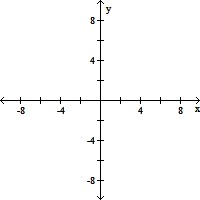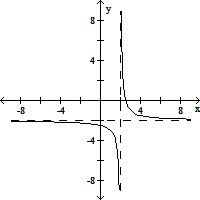For the rational function below (i) Find the intercepts for the graph; (ii) Determine the domain; (iii) Find any vertical or horizontal asymptotes for the graph; (iv) Sketch any asymptotes as dashed lines. Then sketch the graph of y = f(x).f(x) = 

A. (i) x intercept: -  ; y intercept: -
; y intercept: - 
(ii) Domain: all real numbers except -2
(iii) Vertical asymptote: x = -2; horizontal asymptote: y = -2
(iv)
B. (i) x intercept: -  ; y intercept: -
; y intercept: - 
(ii) Domain: all real numbers except -2
(iii) Vertical asymptote: x = -2; horizontal asymptote: y = -2
(iv)
C. (i) x intercept:  ; y intercept: -
; y intercept: - 
(ii) Domain: all real numbers except 2
(iii) Vertical asymptote: x = 2; horizontal asymptote: y = -2
(iv)
D. (i) x intercept:  ; y intercept: -
; y intercept: - 
(ii) Domain: all real numbers except 2
(iii) Vertical asymptote: x = 2; horizontal asymptote: y = -2
(iv)
Answer: A
You might also like to view...
Write the numeral in base ten.555six
A. 215 B. 110 C. 82 D. 1000
Find the exact value of the expression using a sum or difference identity.cos ( )
)
A. -  (
( - 1)
- 1)
B. 
C. - 
D.  (
( + 1)
+ 1)
State whether the function is a polynomial function or not. If it is, give its degree.f(x) = 5x + 6x3
A. Yes; degree 6 B. Yes; degree 3 C. Yes; degree 1 D. Yes; degree 5
Fill in the blank with one of the words or phrases listed below.  The
The  are 0, 1, 2, 3, . . .
are 0, 1, 2, 3, . . .
A. whole numbers B. place value C. factor D. digits